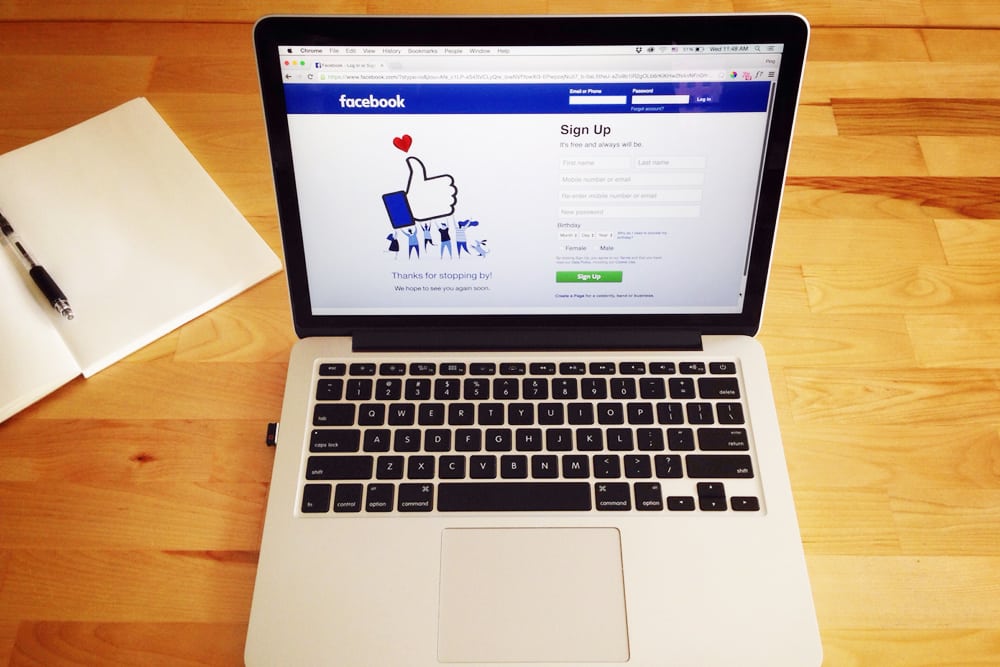Editor’s Note: As we are building our SkiftEDU service for marketers and SMBs in travel, we recently launched a new initiative: our new weekly series on digital marketing tips and tricks, SkiftEDU How-Tos. These How-Tos are a series of free in-depth weekly articles around various topics in digital marketing, such as this one below.
Did you know that approximately 10% of all online traffic now comes from Facebook and nearly 3 million links are shared every hour? Did you also know that even social interactions, such as likes, comments or shares on Facebook, Twitter and Google+ are associated with better search engine rankings?
While Facebook is the undisputed worldwide leader in social media, its algorithm is constantly evolving. Moreover, because Facebook is a for-profit company, organic reach tends to be declining in favor of its advertising options. This is why only 2-3% of your fans actually see your posts. As of today, Facebook only presents the most relevant content to users, ensuring that it promotes the most engaging post or post from friends and relatives rather than from brands. In other words, rich stories, which represent approximately 300 posts in users’ feeds, are displayed out of a potential total of 1500!
Read also Skift special report:
How to Harness The Facebook Ecosystem in 2016
Thanks to its artificial intelligence, Facebook will prioritize interests and the best social interactions in our network. Just because you like a page does not mean you’ll automatically view more posts from it— unless it’s paid for! And still, that’s not even guaranteed…
According to Statistica, users mainly use Facebook to:
- like a post (80%),
- view a video (54%),
- read an article or send a message to a friend (47%),
- or read a new story (46%).
Due to these inherent changes, how can travel brands ensure organic reach with Facebook? Here are our 5 tips to maximize your performance on this ever increasingly intelligent social media network.
1. Avoid relying only on scheduled posts
Even if Facebook has its own algorithm, it remains nevertheless a social media platform. By definition, its success resides on human contact! Your posts must reflect the present moment and feature rich, varied and exclusive content. Engaging in conversations with your target audiences means going beyond just driving them to your products or services. Don’t forget that people want to read about things that interest them — not what you absolutely want them to see.
In addition, be loyal to your followers; take the time to answer each comment. The way you interact with your audience says a lot about the level of your customer service. Did you know it is estimated that only 30% of brands active on Facebook answer comments and questions? Just like with reviews sites such as Yelp or TripAdvisor, your online reputation management depends highly of how you interact on Facebook, and making sure posts don’t seem automated or too corporate.
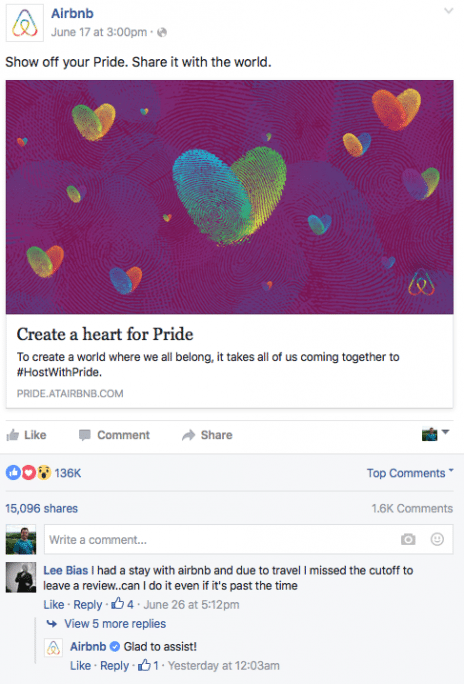
2. Think strategically: Post less frequently, focus on interactions
Facebook is based on interests, not intentions. Due to the sheer quantity of content that is posted, don’t focus on the number of posts you make. Rather, keep your eye on relevancy.
Just as important: never go overboard with your Facebook promotions. A rule of thumb: for every 100 posts, you should post 80 updates (ex.: travel destination guides), links or relevant information for travelers (weather updates, show announcements, answer popular queries, etc.) and only 20 promotions (ex.: special, last-minute rebates).
The following is the best way to accomplish this:
- Create responsive visual content to trigger interest for your posts across all devices (pictures, videos, 360 videos). According to Webbed Feet, 52% of Facebook users say their friends’ photos inspire their travel plans!
- Display customer recommendations, received either in person, by letter or through popular reviews sites
- Posts made up of 80 characters or less get up to 40% more interactions (likes, comments, shares)
- Create content that incites a reaction, curiosity or an emotion. For example:
- Engage audiences with funny posts
- Inspire audiences with Pinterest boards that cover specific aspects of a destination or travel brand experience
- Relate with audiences by sharing stories about common travel adventures (ex.: losing luggage, best places to eat, etc.)
- Actively initiate dialogue with your followers
- Provide audiences with educational information
- Poll your followers on their travel preferences and ask them to select their dream vacations by choosing an emoji or expressing their thoughts


Make sure that with each post, you use keywords that evoke emotions with your followers. You can even use tools, such as CoSchedule to test out your posts’ titles.

3. Post at the right moment
While most brands post at the end of the morning, near lunchtime, true engagement (the precise action of liking, sharing or commenting) happens between 10 p.m. and midnight. That being said, there are no 100% ideal times to post on Facebook. Each audience in each market sector may have different social behaviour. That’s why it is so important to test different times to post and monitor the level of engagement.
Don’t forget: if you cater to a clientele located in several countries, your Facebook stats may be skewed due to all the different time zones.
Your best bet? Leverage the data gleaned from Facebook Insights. To find out the hours and days during which your followers are less engaged, check the “Posts” sub-tab. Test drive your engagement levels by posting during times when your competitors are less active. Tools, including Sprout Social, will help you to better analyze the type of content that triggers the most interest. Other solutions, such as Hootsuite and Buffer, can help you gain deeper insight into the traffic on your page.
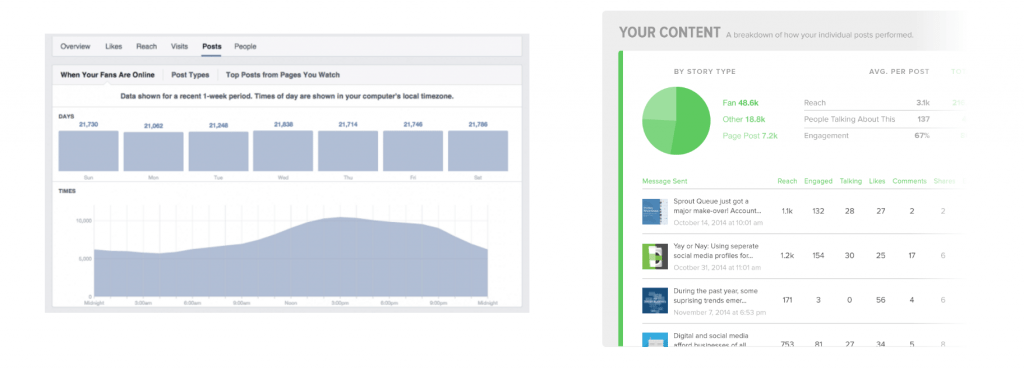
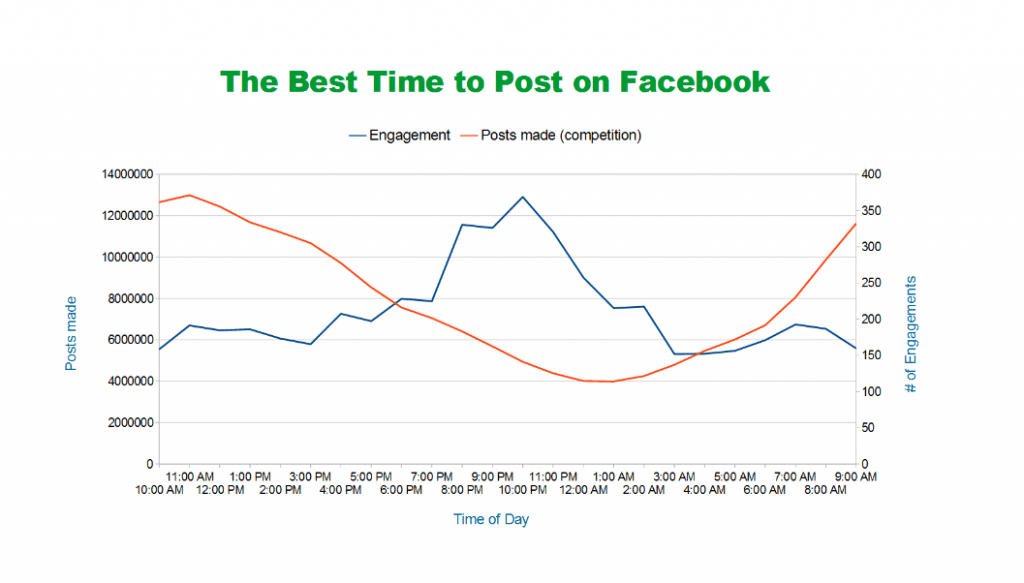
4. Educate your followers
Remind your followers that they can choose, in the Pages Feed located section on the right-hand sidebar, the content they would like to receive so that they never miss a beat. They can even opt to view all of your posts by selecting the frequency. Why not let them know? When someone asks you for information (which can be found in a post you have already published, but the follower never saw it), it would be a great opportunity to let them in on this simple trick.



Useful tip: Make sure to post this procedure not only on your Facebook page but also in your newsletter, website, blog or with reminders on other social media, i.e. Twitter, Snapchat, etc. By the way, this is what selected post will look like in your newsfeed:

5. Engagement and marketing objectives
A 1% level of engagement is considered good for most industries, but for travel & hospitality pages it’s not uncommon to see rates around 4-5%, sometimes more for love brands during seasonal peaks, i.e. ski resorts after a snowstorm with crazy pics posted on their page. If you achieve less than 1%, you should review your editorial guidelines and find ways to better meet the needs of your target audience.
NOTE: How do you calculate page engagement? Simply take the PTAT (people talking about this) stat on any given Facebook page – this calculates likes, comments, shares and tags on the page during the past 7 days -, under the “Like” tab, and divide it by the number of fans on that page. This figure evolves constantly, yet it’s universal enough to allow for comparisons over time as well as against the competition. For example, Tourism Australia had a 5% engagement when we looked at it recently. Pretty good for a page with more than 7M likes!

However, always keep in mind your marketing objectives and that engagement is worth nothing unless it drives your audience to perform a specific action. Another interesting fact: 50% of travel companies recently said that direct bookings have been generated from social media, according to Tnooz.
Facebook now enables contextual calls to action with buttons embedded directly in posts, such as:
- Buy
- Reserve now
- Learn more
- Sign up
- Download

In order to offer these call-to-actions within a post, you must go through Power Editor, a Facebook tool that gives more options when it comes to managing a page, in particular for more sophisticated ad campaigns. Make sure to click on the drop-down menu besides the “call-to-action” mention.
A recent study carried out by Kentic Social showed that the hotels and resort sector on Facebook has the highest average click-through rate, with 2.63% compared with retail, which hovers at 1.27%. There is a lot of potential here, which can be achieved through organic reach, assuming a page has dynamic content shared on a consistent basis.
Bonus Tip: Videos are hot
With over 50 million active page accounts on Facebook, it’s surprising to read that only about 10% of them feature at least one native video on their pages, particularly when knowing that there are now more than 10 billion video views…per day! That’s as much as YouTube, where most travel brands have a channel or drop their latest videos. Yet, it’s been proven that videos uploaded directly onto a Facebook page (native), rather than sharing the YouTube link where the video resides, perform much better and get more traction and interaction with audiences.
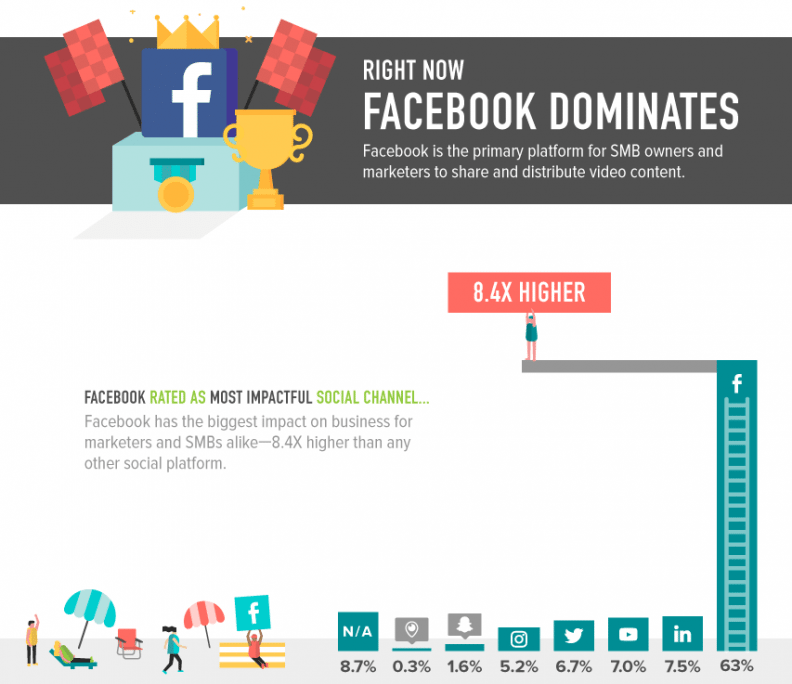
Source: Animoto
Facebook is pushing full-steam ahead with more features to make videos and 360 photos easier to use than ever, specifically with Facebook Live, which has been made available to all pages since April 12, 2016 (from mobile devices). Many inns, boutique hotels, museums, festivals and even destinations are testing this new feature to build hype and excitement about upcoming events or trips, answering customer queries or even present staff, or featuring exclusive behind-the-scene moments.
Mistakes to avoid
- Don’t ask your followers to like your post. Facebook’s algorithm penalizes these types of requests (like-baiting). Instead, focus on getting followers to naturally like your posts thanks to stellar content.
- When you insert a link, use the link tool rather than inserting a picture—even if there is an image in your post. Facebook prefers this practice.
- Don’t use link shorteners, such as Bit.ly. Engagement is 3 times higher with original links!
- Don’t be shy to intervene in a discussion on a competitor’s page that attracts a similar audience. While the goal is not to spam the page, if a customer does not receive any answers from your competitor, you can help pinpoint him or her in the right direct. For example, you can engage with a competitor’s follower if she asks if January is a good time to visit X location.
- Don’t use misleading clickbait like we see too often. For example, don’t write “Wait until you see what happened to this tourist.” Instead, write: “This traveler learned the hard way of the dangers of local fauna.”
Despite of our best efforts, Facebook will become less and less a platform for engagement and more a means to advertise to followers. Thanks to its understanding of follower behaviour, emotions, location and purchasing decisions, Facebook is thus transforming itself into a powerful marketing tool that will help driving customer intention.
The only constant with Facebook is change; that’s why it is so important to take care of all your digital media platforms, including your website and blog. You can write exclusive posts on Facebook, but never underestimate the potential of ebooks, case studies or videos on your blog for inbound traffic, lead generation and customer engagement. Sharing these on Facebook will become a complement, rather than a panacea for your online marketing initiatives. Take advantage of using all of your social media platforms for maximum visibility, such as broadcasting a YouTube video, posting a Facebook message, and share your latest blog article regarding tips for travelers.
And of course, while we covered many tips on how to better perform on Facebook for organic reach, we will certainly cover how to use the network for advertising purposes in upcoming articles. Because at the end of the day, it has certainly become a must for most travel brands that have a digital marketing strategy in place and with specific goals to meet.
The Daily Newsletter
Our daily coverage of the global travel industry. Written by editors and analysts from across Skift’s brands.
Have a confidential tip for Skift? Get in touch
Tags: Skift EDU
